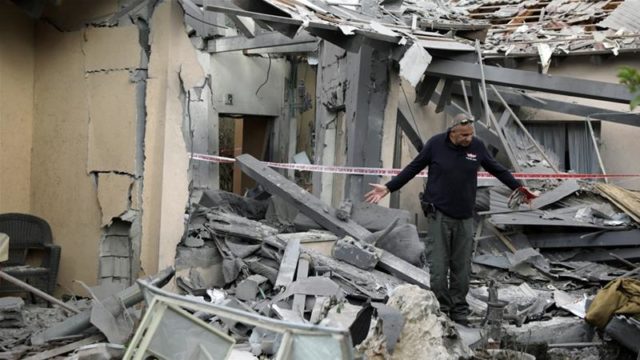
“The job of a soldier is to be killed before a citizen is killed.” This is a rough translation of the sentence spoken by a Golani commander in 2007 at the March 2007 draftees’ Tekes Hashba’ah (swearing in ceremony) for Golani’s 51 regiment. The meaning of this grim message is very clear: the Army is there to protect the citizens, not the other way around.
For five years, Israel has relatively successfully managed Gaza terror without a large-scale operation; this past year has shown that this is no longer the case. Since April, four major red lines have been crossed. Hamas has used sniper fire against IDF soldiers, killed a civilian by targeting his car with an advanced precision-guided anti-tank missiles, and killed the first Israeli civilian by rocket fire since the end of Operation Protective Edge in 2014. In addition, the IDF discovered a complex tunnel system penetrating into Israel.
Israel needs a new paradigm vis-à-vis Gaza, one that improves its strategic as well as operational situation, allowing the IDF to stand on the front line and better protect the citizens of Israel.
Creating a buffer zone inside Gaza can do this.
Many commentators see Israel as having to choose between continuously managing escalation or reoccupying the Gaza Strip in what would turn into a long-term quagmire. Others propose hitting Hamas harder from the air and engaging in limited incursions. Continuing the status-quo is rapidly failing, reoccupying Gaza would indeed be an unnecessary and undesirable quagmire, while turning Gaza over to the PA would require initial IDF reoccupation for an unknown duration and would be a dubious and risky gamble.
Even increased airstrikes and limited incursions, up to the level of Operations Cast Lead and Protective Edge, have shown to be a short-term solution at best because Hamas and PIJ can still claim victory, as they did in both conflicts, just for standing up and bloodying a stronger power, surviving, and firing rockets up until the cease-fire.
Israel can deter Hamas by denying it a propaganda victory and improve its security as well. The next time there is any sort of escalation, Israel should take military control approximately one kilometer into Gaza on all sides of the Strip bordering Israeli territory.
The exact distance would vary depending on the geography. Israel should move its border perimeter forward into Gaza, building secure bases and a secure barrier and declaring the area a closed military zone with no new Israeli civilian communities moving forward into the new space. It should enforce this new security situation by responding with heavy force to any act of war from Gaza, treating the launch of an incendiary balloon, an attack on Ashkelon, or an attack on Tel Aviv in exactly the same way.
The most important strategic benefit of this plan would be to deny Hamas a propaganda victory. The control of territory has always been the primary measure of success in war. Even Hamas cannot claim to have won a round with Israel when it has lost territory to it. Hamas’s fear of losing more territory and a further blow to its prestige would reinvigorate Israel’s deterrence.
Showing that Israel can and will hand Hamas a defeat that it cannot even deny to its own supporters would make Hamas more hesitant to attack Israel and might even eventually lead to Hamas willingly moderating its ideology in exchange for peace. It was not until Israel decisively defeated Egypt, including the capture of vast swaths of territory, that Egypt became willing to negotiate. While peace may be a distant dream and deterrence will be tested, the operational benefits of a buffer zone are clear.
The creation of a military buffer zone benefits Israel’s operational situation and national security. Having Israeli communities one kilometer further from the (new) Gaza border would increase the distance terrorists would have to tunnel to get into Israel and threaten Israeli communities. Each tunnel would take potentially twice as long to build and require double the resources, significantly cutting the threat.
The creation of even a kilometer of strategic depth also greatly reduces the arsenal that Gaza based terrorists can fire at Israeli communities. Short-range mortars cause havoc in bordering communities and are not in the air long enough to be intercepted by Iron Dome. Moving the border forward would drastically reduce the mortar threat and would all but eliminate the ability to target Israeli civilian drivers with antitank missiles. It would also distance the violent daily protests from the southern borders that continuously terrorize border communities.
This strategy would not stop Hamas and PIJ from trying to attack Israel, but neither does the current strategy. The difference is that Israel would be positioned geographically to defend against those attacks and would be more credible in its threat to make these groups pay a severe price for escalation.
It should not change the international position either. The territory will not be settled and can be returned to PA control in a final status peace deal if and when one was to obtain. Israel will need to articulate this clearly to the international community, but if there ever was an international environment permissive enough for Israel to take the risk and enact this policy, it exists today with the Trump administration voicing unequivocal support for Israel’s right to defend itself against Gaza based terrorists.
When it comes to Israel’s security, history has clearly shown that what matters most of all is facts on the ground. The capture of border territory runs a middle road between toppling Hamas, which would be costly and unpredictable, retaking control of Gaza, which is undesirable, and continuing a status quo in which Hamas and other terror organizations increasingly have the initiative. While implementing this strategy would be costly and would entail casualties, Israel should hew to its traditional position – using its Army when needed to protect its civilians, not accept civilian casualties to protect its Army.
Thankfully, the soldiers of the IDF know this well.

